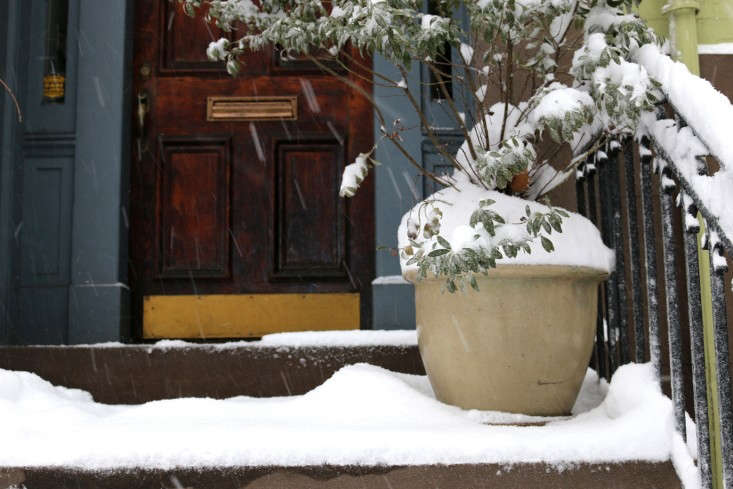Is it cold and gray outside your window, or has November not yet started to afflict you?
Winter is coming. Best to get in front of it. Prepare your patio, deck, or backyard now, before you actually need to, and then congratulate yourself for your foresight when the first storm hits.
Here’s a checklist of nine ways to winterize outdoor spaces:
1. Shelter the Outdoor Furniture.

Bring wicker furniture indoors during winter months, or store it in a dry garage or shed.
If you have weather-resistant wood furniture (such as teak) that can stay outdoors in bad weather, it’s a good idea to move it to a sheltered spot if possible—stack it under an eave behind the garage, or move it to a spot where it’s out of the winde.
2. Cover the Outdoor Furniture

An alternative to custom covers, inexpensive generic outdoor furniture covers are also plentiful through Amazon, Home Depot, Lowe’s, and other furniture retailers, writes Janet. Read more in Hardscaping 101: How to Care for Wood Outdoor Furniture.
Protective covers are often available for specific lines of furniture, such as Brown Jordan’s Lounge Chair Cover, for an exact fit.
3. Check the Deck

Decking and wood floors may need maintenance. After being exposed to rain, wind, and temperature changes, nails may pop up, board may sag or loosen and sealants may wear off.
Make sure nothing is rotting and that the surface feels solid and tight.
4. Clean Decking and Pavers

Brush or scrub off mold, mildew or moss that has accumulated on decking and then apply an annual coat of waterproof sealer.
5. Protect Planters

Make sure planters that can’t come inside are really weatherproof (terra cotta tends to crack). If a pot seems fragile but is too large to live indoors during winter? Empty it, turn it upside down so water can’t collect inside, and elevate it so that the rim doesn’t freeze against the ground. See more tips in Gardening 101: How to Prevent Cracks in Terra Cotta Planters.
6. Refill Bird Feeders

“In much of North America, winter is a difficult time for birds,” notes the Cornell University Laboratory of Ornithology’s Bird Notes newsletter. “The lush berry-laden vegetation of summer and fall has withered or been consumed, and most insects have died or become dormant. Finding food can be especially challenging for birds during days with extreme cold temperatures.”
Backyard bird feeders to the rescue. Fill yours now in preparation for the cold months ahead—and refill it as necessary.
7. Choose the Best Bird Feed

The best choice for bird food? When in doubt, buy black-oil sunflower seeds (to feed the greatest number of species,” say the birders at Cornell: black-oil sunflower seeds “have a high meat-to-shell ratio, they are nutritious and high in fat, and their small size and thin shells make them easy for small birds to handle and crack.”
A 30-pounds back bag of Black Oil Sunflower Seeds is $31.99 from Petco.
8. Clean the Grill

If your grill burns charcoal or wood, empty the ashes and scrub the grates. If you have a gas grill, shut off the gas line and store the gas tank in a dry, cool spot in the garage or a shed.
9. Prune Low-Hanging Branches

Inspect trees that have branches that hang over a patio, driveway, garage, or shed—and prune low-hanging ones that could snap off under the weight of heavy snow or ice.
Finally, are you planning a Decks & Patios project? Learn everything you need to know on to get started with our Hardscaping 101: Decks & Patios 101 guide.
N.B.: We know you don’t want to think about this yet, but … Ask the Expert: Garden Friendly De-Icing Techniques. Again, better to be prepared.











Have a Question or Comment About This Post?
Join the conversation